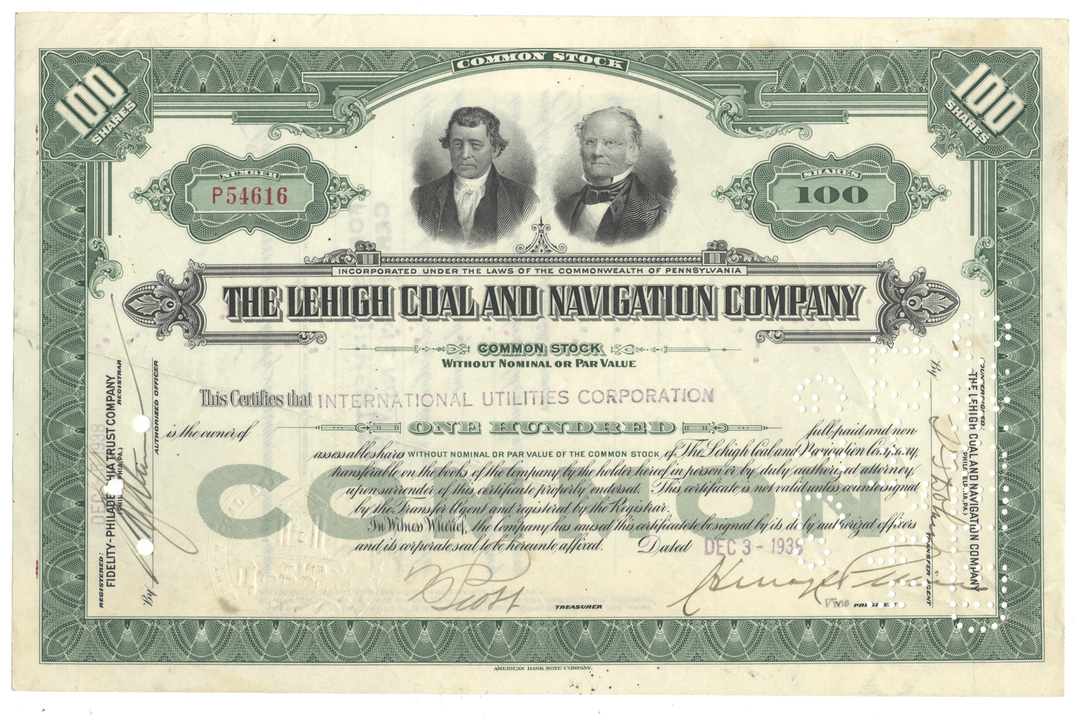
Lehigh Coal and Navigation Company
- Guaranteed authentic document
- Orders over $75 ship FREE to U. S. addresses
Product Details
| Company | Lehigh Coal and Navigation Company |
| Certificate Type | Common Stock |
| Date Issued | December 3, 1938 |
| Canceled | Yes |
| Printer | American Bank Note Company |
| Signatures | Machine printed |
| Approximate Size |
11" (w) by 7" (h) |
|
Product Images |
Show the exact certificate you will receive |
| Authentic | Yes |
| Additional Details | NA |
Historical Context
The Lehigh Coal and Navigation Company was one of the most important corporations in America's history. Its founders, Josiah White and Erskine Hazard, played a major role in the American "industrial revolution" through the company's catalytic influence on the development of anthracite coal mining, canal technology, railroads, iron production, and wire rope.
The Lehigh Coal and Navigation Company was an outgrowth of the earlier Lehigh Coal Mine Company. This concern had unsuccessfully attempted to transport and market anthracite from the large deposits near what is now Summit Hill, Pennsylvania, to Philadelphia via the Lehigh and Delaware Rivers. Sporadically active between the years of 1792 and 1814, the Lehigh Coal Mine Company was able to sell some of its coal to Josiah White and Erskine Hazard who operated a wire mill at the Falls of the Schuylkill near Philadelphia. These two innovative entrepreneurs leased the Lehigh Coal Mine company's properties in 1817. Having earlier displayed great technological skills by creating the world's first iron wire suspension bridge, which spanned the Schuylkill at their wire works. White and Hazard planned to tame the turbulent Lehigh River by creating an effective navigation system. By 1818 they had organized the separate Lehigh Coal Company and the Lehigh Navigation Company to accomplish their plans. Within the next two years. White and Hazard constructed a descending navigation system which utilized their unique "bear trap" or hydrostatic locks, which allowed the passage of coal boats by means of artificial floods. By 1821 the Lehigh Coal and Lehigh Navigation companies were merged. Formally Incorporated in 1822, the Lehigh Coal and Navigation Company was transporting large amounts of coal to Philadelphia by 1824.
In order to bring more coal from the mines to their navigation system, the Company constructed America's second railroad in 1827-28. During these same years it also began the conversion of its descending navigation system into a two-way system. Completed in 1829, this improved Lehigh Navigation system had the largest carrying capacity of any canal in the United States. Stretching from Mauch Chunk to Easton, this waterway was soon connected to both New York and Philadelphia by the completion of the Morris and Delaware Canals in 1832 and 1833 respectively.
To take advantage of this new and improved access to America's largest metropolitan markets, the Lehigh Coal and Navigation Company made a concerted effort to develop the water power sites along its waterways into early industrial parks. The Abbott Street area, near Lock 47, which is now part of Easton's Hugh Moore Park, employed over 1,000 men in almost a dozen manufacturing establishments by 1840.
Related Collections
Additional Information
Certificates carry no value on any of today's financial indexes and no transfer of ownership is implied. All items offered are collectible in nature only. So, you can frame them, but you can't cash them in!
All of our pieces are original - we do not sell reproductions. If you ever find out that one of our pieces is not authentic, you may return it for a full refund of the purchase price and any associated shipping charges.





